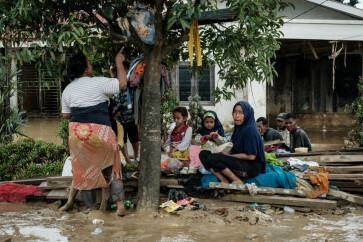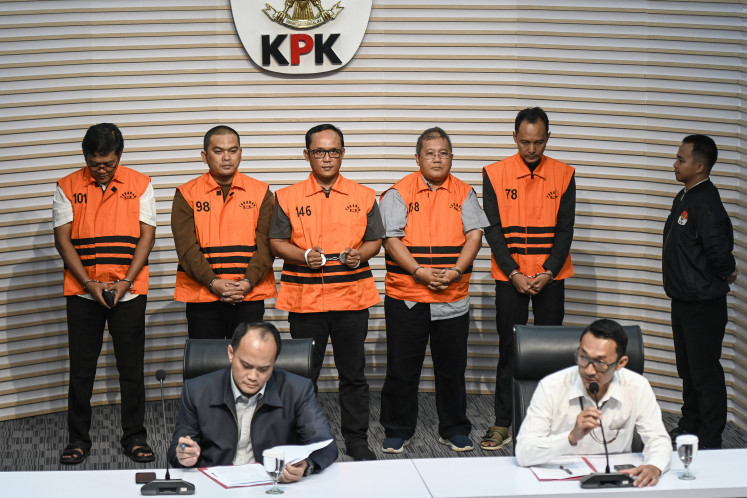Popular Reads
Top Results
Can't find what you're looking for?
View all search resultsPopular Reads
Top Results
Can't find what you're looking for?
View all search resultsIf US attempts World Bank retreat, China-led AIIB could step in
The AIIB is a paradox: an institution connected to the rules and norms of the liberal international order, but one created by an illiberal regime.
Change text size
Gift Premium Articles
to Anyone
U
nited States President Donald Trump’s animosity toward multilateralism and international organizations is well known. Just hours after taking office on Jan 20, the president announced his intention to withdraw from the World Health Organization and the Paris agreement on climate change.
Could the International Monetary Fund and the World Bank be next?
Any shrinking of US leadership in international financial institutions would, I believe, run counter to the administration’s ostensible geopolitical goals, creating a vacuum for China to step into and take on a bigger global role.
In particular, weakening the World Bank and other multilateral development banks (MDBs), that have a large US presence could present an opportunity for a little-known, relatively new Chinese-led international organization: the Asian Infrastructure Investment Bank (AIIB), which, since its inception, has supported the very multilateralism the US is attacking.
The AIIB was created by China nine years ago as a way to invest in infrastructure and other related sectors in Asia, while promoting “regional cooperation and partnership in addressing development challenges by working in close collaboration with other multilateral and bilateral development institutions.”
This may run counter to the image of Beijing’s global efforts portrayed by China hawks, of which there are many in the Trump administration, who often present a vision of a China intent on undermining the Western-led liberal international order.
But as a number of scholars and other China experts have suggested, Beijing’s strategies in global economic governance are often nuanced, with actions that both support and undermine the liberal global order.
As I explore in my new book, it is clear that today the AIIB is a paradox: an institution connected to the rules and norms of the liberal international order, but one created by an illiberal government.
For decades, MDBs have served the important task of lending billions of dollars annually to support economic and social development.
They can be vital sources of funding for poverty reduction, inclusive economic growth and sustainable development, with a newer emphasis on climate change.
At the same time, MDBs perennially face criticism from civil society organizations that highlight areas of weak performance and are concerned about potential downsides of the major MDBs’ greater emphasis on working more closely with the private sector.
When Chinese President Xi Jinping in 2013 proposed creating the AIIB to lend for infrastructure development in Asia, there was a lot of suspicion among major nations about China’s intentions.
Nonetheless, major nonborrowing nations, with the exception of Japan, joined the new bank. Today, the AIIB is the second-largest MDB in terms of member countries, behind only the World Bank.
From the get-go, the AIIB was designed to be cooperative. Jin Liqun, who became the bank’s first president, is a longtime multilateralist with a long career at China’s finance ministry and past positions on the boards of the World Bank and the Global Environmental Facility, as well as a vice presidency of the Asian Development Bank.
The international group of experts that helped design the AIIB also included former executive directors and staff from the IMF and other development banks, as well as two Americans with long careers at the World Bank who played leading roles in designing the bank’s articles of agreement and its environmental and social framework.
The bank fits into the landscape of other MDBs in a variety of ways. The AIIB’s charter is directly modeled on the Asian Development Bank’s foundation, and built into the AIIB’s charter is the bank’s mission of promoting “regional cooperation and partnership in addressing development challenges.”
The AIIB shares similar norms and policies with other major MDBs, including its environmental and social standards.
Alongside borrowing foundational principles, the AIIB also works in close conjunction with its peers. The World Bank initially ran the AIIB’s treasury operations. The AIIB has also co-financed a high percentage of its projects with other MDBs, particularly in its first years.
In a recent sign of cooperation, in 2023, a deal between the AIIB and World Bank’s International Bank for Reconstruction and Development (IBRD) saw the AIIB issue up to US$1 billion in guarantees against IBRD sovereign-backed loans. This increased the IBRD’s ability to lend more money, while diversifying the AIIB’s loan portfolio.
As of Feb. 6 the AIIB had 306 approved projects totaling $59 billion. Energy and transportation are its two largest sectors of lending. Recently approved projects include loans to support wind power plants in Uzbekistan and Kazakhstan, and a solar plant in India. India, which has a bumpy relationship with China, is one of the bank’s largest borrowers, along with Turkey and Indonesia.
From its birth until recently, the multilateral AIIB has repeatedly distinguished itself from China’s bilateral initiatives. Chief among those is China’s Belt and Road Initiative, an umbrella term for infrastructure lending by Chinese institutions that has been criticized for lacking transparency and accountability.
Indeed, some Belt and Road Initiative-linked projects have faced concerns about corruption, costs and the opacity of the loan agreements.
In the past several years, the AIIB has made more mention of synergy with Belt and Road lenders, and the bank now hosts the secretariat of a facility, the Multilateral Cooperation Center for Development Finance, that offers grants and support to developing countries seeking to finance infrastructure in countries where Belt and Road lending takes place. This may blur the line between the AIIB and lending under the Belt and Road umbrella, but it does not appear to weaken the bank’s standards.
As the new US administration formulates its policies toward China, it would do well to take into account the variation in China’s strategies in global economic governance, as a recognition of areas of cooperation, competition and conflict requires more nuanced responses. In many areas, the US will both cooperate and compete with China.
Paradoxically, any moves by the Trump administration to pull back from multilateral organizations may leave the AIIB, whether or not it is an anomaly, in a position to offer a better model of cooperation than leading MDBs with a powerful US role.
---
The writer is an associate professor at American University. The article is published under a Creative Commons license.











